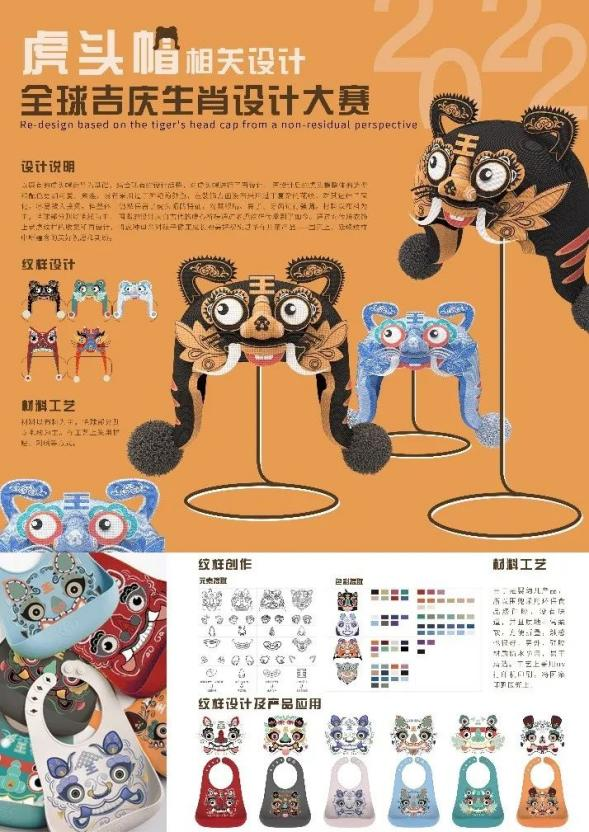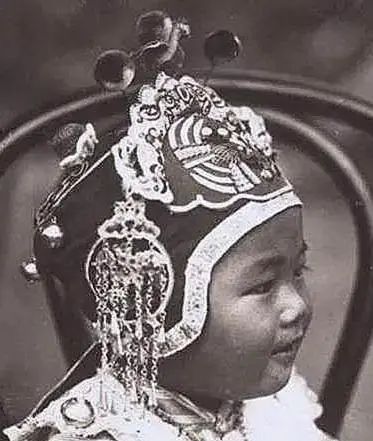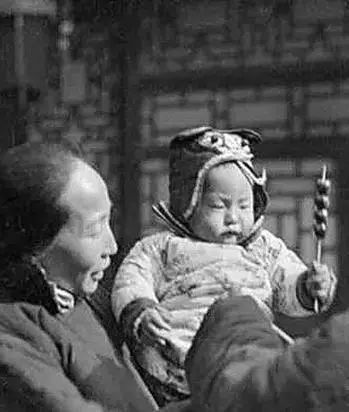 >
国际
>
国际
吉庆生肖 | 虎头帽——绣出古今父母的爱与寄托
发布时间:2022-07-01 13:22:15 | 来源:中国网 | 作者: | 责任编辑:刘怿艺吉庆生肖 |虎头帽——绣出古今父母的爱与寄托
Chinese Zodiac Stories|Tiger-head Hats: A Carrier of Parental Love
全球吉庆生肖设计大赛
Global Chinese Zodiac Design Competition
全球吉庆生肖设计大赛是由北京市文化和旅游局联合中央美术学院共同主办,北京市海外文化交流中心承办的旨在宣传和推广中国生肖文化的大型赛事和推广活动。自2014年举办以来,已连续举办8届,累计收到来自海内外设计作品20000余件,获奖作品300余件。参加作品征集的累计来自国内各地及海外30余个国家和地区的两万名设计师参与了大赛。
The Global Chinese Zodiac Design Competition, sponsored by the Beijing Municipal Bureau of Culture and Tourism and the Central Academy of Fine Arts and organized by the Beijing Overseas Cultural Exchanges Center, is a large-scale event to publicize and promote China’s zodiac culture. Since its inauguration in 2014, eight editions of the event have been held, receiving a total of over 20,000 entries from both home and abroad, of which over 300 won prizes at the competition. The event has attracted some 20,000 designers from more than 30 countries and regions to participate.
“吉庆年年——壬寅虎年生肖设计线上虚拟展厅”
已经正式上线与大家见面了
“Year of Auspice – Virtual Exhibition for Zodiac Designs of the Year of the Tiger” has gone online.
扫码观展
Scan to enjoy the exhibition
“吉庆年年——壬寅虎年生肖设计展”展出了全球吉庆生肖设计大赛(壬寅虎年)的全部获奖作品,并特别邀请了12位当代艺术家创作的13件生肖艺术品展出。
“Year of Auspice – Virtual Exhibition for Zodiac Designs of the Year of the Tiger”displays all prize winners at the Global Chinese Zodiac Design Competition 2022 (the Year of the Tiger), as well as 13 zodiac artworks by 12 contemporary artists.
展厅内作品展示
Works on display
在参观展览的时候大家不难发现,很多参赛作品的设计理念背后还有着很深刻的中国传统文化故事,比如本期我们要讲述的这幅以“虎头帽”为灵感的作品:
At the exhibition, visitors can easily find that the design ideas of many works were inspired by stories of traditional Chinese culture, such as the tiger-head hat we talk about here.
2022全球吉庆生肖设计大赛
(壬寅虎年)
产品设计一等奖
《虎头帽相关设计》
Global Chinese Zodiac Design Competition 2022 (the Year of the Tiger)
First Prize for Product Design
“Tiger-head Hat and Relevant Designs”

【设计说明】
Description
以原有的虎头帽造型为基础,结合现有的设计趋势,对虎头帽进行了再设计。再设计后的虎头帽整体的造型和配色更加可爱、素雅,没有采用过于鲜艳的颜色,在装饰方面没有采用过于复杂的花纹,对其进行了简化,容易被人接受。但整体上仍然保留了虎头帽的特征,对其眼睛、鼻子、牙齿进行强调。材料以布料为主,毛球部分则以毛线为主。围嘴的设计来自古代的虔心祈祷通过老虎纹样传承到了如今。通过对传统衣饰上老虎纹样的收集和再设计,将这种母亲对孩子健康成长的美好祝愿赋予在儿童产品——围兜上,延续纹样中所蕴含的美好祝愿和期盼。
The designer redesigned a traditional tiger-head hat by introducing modern elements, making the work more adorable and elegant in terms of shape and color. Instead of bright colors and complicated decorative patterns, this simple design style makes it easier to be accepted. Generally, it retains the features of traditional tiger-head hat and highlights elements such as the eyes, nose, and teeth. With cloth as the main material, the work adopts wool to make the hairballs. The bib inherits the ancient tiger-heart pattern. Through collection and redesign of traditional tiger patterns, the designer conveys the mother’s good wish for healthy growth of her child with this bib, as a continuity of the auspicious connotations of those traditional patterns.
中国传统文化民间艺术
虎头帽
Tiger-head Hats: Traditional Chinese Folk Craft
虎头帽主要分为两种,一种是古代武士所戴的虎头形头盔,第二种是清末民初儿童所带的虎头形帽子。
In the past, tiger-head headwear fell into two categories: tiger-head helmets worn by ancient warriors and tiger-head hats popular among children in the late Qing Dynasty (1644-1911) and the early Republic of China period (1912-1949).
武士虎头帽
Tiger-head Helmets for Warriors

三彩虎头盔武士俑,出土于西安洪庆
This tri-color terracotta warrior wearing a tiger-head helmet was unearthed in Hongqing, Xi’an.
隋代时期,以带虎头盔、着明光铠的武士俑形式在墓葬中保留下来,证明带虎头盔的武士形象开始出现在世俗文化中。
During the Sui Dynasty (581-618), terracotta warriors wearing tiger-head helmets and bright armors were often used as burial objects. This indicates that warriors with tiger-head helmets began to appear in popular culture at that time.
到了唐朝,虎头帽武士俑在西安、洛阳等地多有出土。唐太宗爱将尉迟敬德墓出土了彩绘虎头帽武士俑、将军俑,可见武士虎头帽至此已经发展到极盛。
Many terracotta warriors with tiger-head helmets have been unearthed from Tang Dynasty (618-907) tombs in Xi’an, Luoyang, and other places. Terracotta warriors and generals wearing tiger-head helmets were found in the tomb of Yuchi Jingde, a favored general of Tang Emperor Li Shimin. This proves that terracotta warriors with tiger-head helmets flourished in the Tang period.
儿童虎头帽
Tiger-head Hats for Kids
现如今常提及的虎头帽多指儿童虎头帽,上古时期的崇虎之风,在历经了数千年纵横交错的动物崇拜、图腾崇拜、祖先崇拜、神灵崇拜阶段后,在世俗化的过程中,逐渐沉淀为了中华民族内心深处的民间虎俗信仰,其影响遍及人类生活的方方面面。当民间虎俗信仰作用于衣饰上,便产生了我国最具代表性的传统童饰——儿童虎饰,它是在民间虎俗信仰的产物,也是古代人类智慧的结晶,我国历代劳动人民借儿童虎饰表达着对美好生活的憧憬与希望。
Nowadays, tiger-head hats mainly refers to headwear with tiger-head patterns for children. The tiger had been a totem worshipped by Chinese ancestors since remote antiquity. Over millennia, after enduring the phases of animal worship, totem worship, ancestral worship, and deity worship, the tiger worship gradually evolved into a folk belief embedded in the hearts of Chinese people, with its influence penetrating into every aspect of human life. As the belief integrated with clothing, it turned into the most representative tiger patterns on kids’ clothes. Tiger-head hats are a fruit of folk tiger belief and a crystallization of ancient Chinese wisdom, which represent laboring people’s aspiration for a better life.


清末照片,戴虎头帽的幼儿
An infant wearing a tiger-head hat in the late Qing Dynasty.
以老虎为形象的虎头帽,是中国民间儿童服饰中比较典型的一种童帽样式。它与虎头鞋、虎围嘴、虎面肚兜等成为儿童服装中重要的组成部分,具有鲜明的特色,这些以虎为形象的儿童服饰寓意深远,深受中国传统虎文化因素的影响。
Tiger-head hats are a typical kind of folk caps for kids in China. Alongside tiger-head shoes and tiger bibs, they constitute integral parts of traditional Chinese children’s clothes. Known for distinctive designs, those children’s clothes featuring tiger patterns are deeply influenced by traditional Chinese tiger culture.
虎头帽的历史渊源
Origins of Tiger-head Hats

唐代虎头帽襁褓陶俑
出土于陕西西安东郊韩森寨唐墓
A terracotta swaddled infant wearing a tiger-head hat, Tang Dynasty, unearthed from a tomb at Hansen Fortress in the eastern suburb of Xi’an, Shaanxi
在西安东郊韩森寨唐墓出土的一件唐代虎头帽襁褓陶俑,是婴儿头戴虎头帽最早的实物例证。俑高10cm,此婴儿俑头戴虎头帽,面庞丰满,内着衫,外裹襁褓,前身系有三条结带,脚部用布包裹系紧。
The terracotta swaddled infant wearing a tiger-head hat, unearthed from a Tang Dynasty tomb at Hansen Fortress in the eastern suburb of Xi’an, is the earliest evidence ever found for kids’ tiger-head hats in China. With a height of 10cm, the terracotta swaddled infant wears a tiger-head hat and a skirt and features a plump face. The swaddle is tied with three ropes, with the infant’s feet tightly wrapped.
但是在宋元明清时期关于儿童虎头帽的文献记载和考古发掘文物并不多,由此可以推测儿童虎头帽应该是始于唐朝的,但是并未在接下来的朝代里盛行。直到上个世纪初期,战争频发,社会动乱,这个时期的孩子们成活率低,人们为了寄托于猛虎之运来庇佑孩子远离邪魔,虎头帽才重新回到了大众的生活当中,逐渐盛行起来。
However, there are only few historical documents and cultural relics about kids’ tiger-head hats dating back to the Song (960-1279), Yuan (1271-1368), Ming (1368-1644) and Qing dynasties. It is conjectured that tiger-head hats originated in the Tang Dynasty but didn’t gain popularity in the following dynasties. In the early 20th century, frequent wars resulted in social turbulence, and the survival rate of newborns was low. Thus, people used the tiger patterns to protect their children from the evil, so that tiger-head hats gradually became popular in daily life.
虎头帽的象征意义
Symbolism of Tiger-head Hats
其实虎头帽的基本功能就是在冬日里给孩子保暖用,主要是在象征意义上显得更为突出。古代中国家长借虎的勇猛强悍之意,用或华丽的丝绸锦缎或朴素的棉麻织布,用鲜艳的颜色绣出既威猛又憨厚的小老虎,表达了对孩子的深爱,希望孩子能够平安幸福,远离疾病,健康成长。
In fact, the basic function of tiger-head hats is to keep children warm in winter, but such hats have distinctive symbolic meaning. The tiger is a symbol of power and strength. In ancient China, parents embroiders fierce and lively tiger patterns on gorgeous silk or simple cotton and linen fabrics to express their love for children, in hopes that such tiger patterns could protect their kids from dangers and diseases and make them safe, happy and healthy.
持续关注“吉庆生肖”栏目
为您带来更多中国传统生肖文化故事
Please follow our program“Chinese Zodiac Stories”
带着文化自觉和文化自信,全球吉庆生肖设计大赛旨在延伸春节和生肖文化内涵,以创新、时尚、国际化的表达方式,讲好中国故事,推广中华优秀文化,增进世界对中国生肖文化的理解和共鸣。之后,本栏目也将继续为您讲述生肖设计大赛作品背后的文化故事,敬请期待。
With cultural consciousness and cultural confidence, the Global Chinese Zodiac Design Competition aims to carry forward cultural connotations of the Spring Festival and Chinese zodiac culture, and tell Chinese stories and spread fine Chinese culture in an innovative, fashionable and internationalized way, so as to promote global understanding and resonance of Chinese zodiac culture. Please stay tuned, and we will tell you stories behind more works at the design competition.


